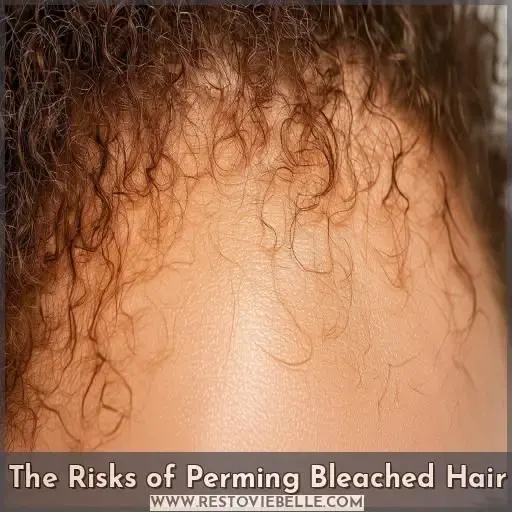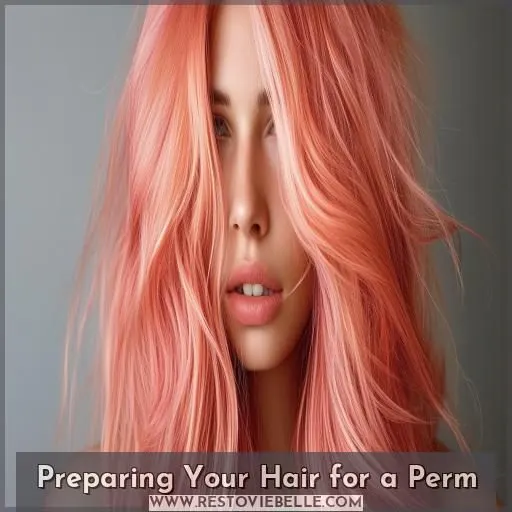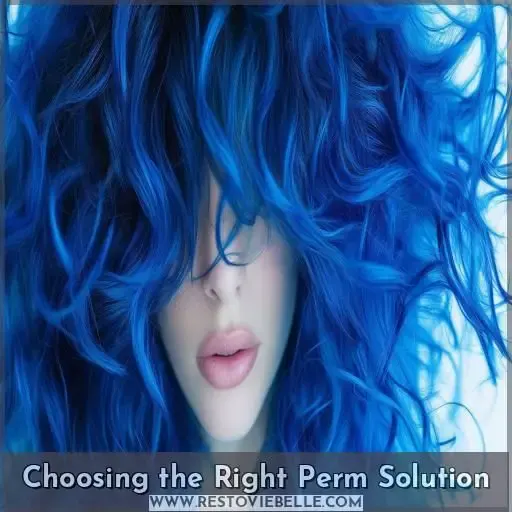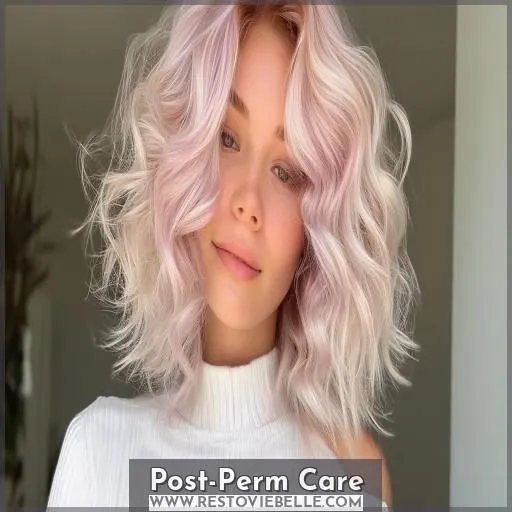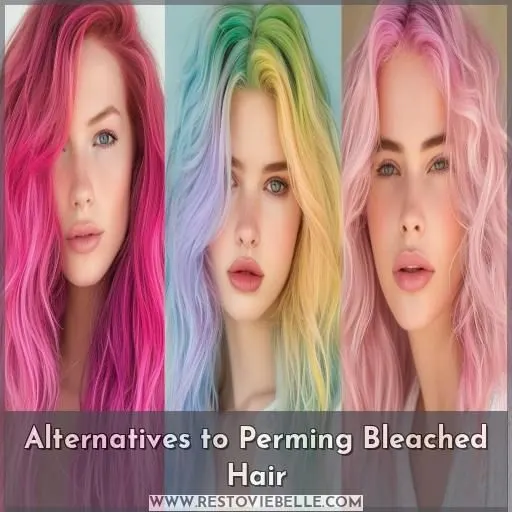This site is supported by our readers. We may earn a commission, at no cost to you, if you purchase through links.
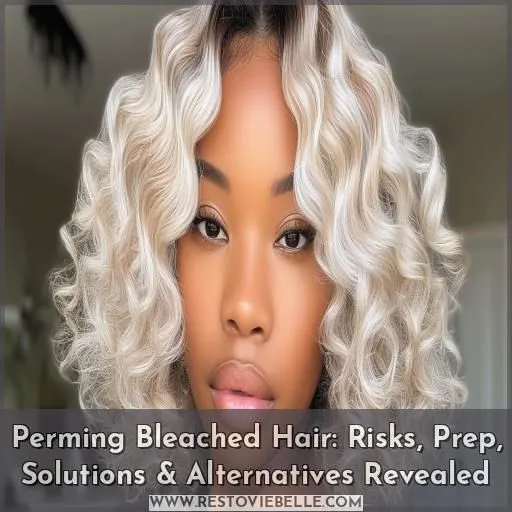 Yes, you can perm bleached hair, but it’s a risky process. Bleaching makes hair porous and fragile, so the harsh chemicals in perms can cause extensive damage, breakage, and uneven results.
Yes, you can perm bleached hair, but it’s a risky process. Bleaching makes hair porous and fragile, so the harsh chemicals in perms can cause extensive damage, breakage, and uneven results.
To minimize risks, deeply condition your locks with protein and moisture treatments beforehand. Opt for low-ammonia or customized perm solutions designed for damaged hair.
After perming, use gentle, sulfate-free products and weekly deep conditioning masks. If your hair can’t handle more chemicals, consider heatless curl methods or extensions instead.
Proper prep and aftercare are essential – keep reading to learn the safest approach.
Table Of Contents
Key Takeaways
- Girl, Perming bleached hair is like walking a tightrope – you better be prepared to navigate those risks! Your locks have been through the wringer already, so slathering on more harsh chemicals? Not the move unless you’re ready for some serious TLC.
- But if you absolutely must have those va-va-voom curls, get your hair in fighting shape first. I’m talkin’ deep conditioning treatments galore – slap on those protein-packed masks like it’s nobody’s business. Your strands need all the nourishment they can get before being exposed to more chemicals.
- When it’s perm time, don’t settle for any old solution. Demand that your stylist whips up a customized, low-ammonia blend made specifically for your parched, bleached locks. That way, you can minimize the chances of ending up with a hot frizzy mess.
- And after you’ve scored those luscious curls? Girl, you better be ready to pamper those locks like a newborn babe. We’re talking sulfate-free everything, overnight satin scarf action, and weekly hair mask sessions. Your hair’s been through enough trauma – time to show it some serious love!
Can You Perm Bleached Hair?
Yes, you can perm bleached hair, but it’s risky and requires extra care. Bleached hair is already damaged, so the harsh chemicals in perm solutions can cause further breakage and uneven results.
The Risks of Perming Bleached Hair
Perming bleached hair can lead to extensive damage and breakage, as the strands have already been weakened by the bleaching process. Additionally, the chemicals involved in perming can cause uneven and inconsistent results on bleached locks, potentially leaving you with an unsatisfactory outcome.
Damage and Breakage
Perming chemically-processed hair heightens risks of damage. You may face increased breakage, split ends, and chemical sensitivity, leading to scalp irritation, hair loss, or allergic reactions. The compromised state leaves strands dry and brittle, prone to snapping under perm’s strain. Carefully weigh bleaching’s toll before perming for desired curls.
Uneven Results
Bleaching can make your hair uneven in density and porosity, leading to inconsistent curl patterns. Areas that took more bleach might underprocess, while virgin sections overprocess. Your texture variations and dyeing history compound the issue. Be upfront about your curl preferences to help stylists customize accordingly.
Preparing Your Hair for a Perm
To prepare bleached hair for a perm, protein treatments are essential to strengthen and rebuild the damaged cuticles. Moisturizing treatments also help restore moisture and elasticity, which bleaching can severely deplete, making the hair more receptive to the perm solution.
Protein Treatments
After bleaching, your hair needs protein treatments to rebuild its strength. Consider these options:
- DIY protein masks with eggs, yogurt, or avocado
- Store-bought protein packs or serums
- Professional keratin treatments
- Deep conditioning with protein-rich products
Properly prepping with protein can minimize breakage and help your perm take better. Don’t skip this crucial step!
Moisturizing Treatments
You’ll also want to moisturize your locks with deep conditioning treatments and moisturizing products. These help replenish your hair’s natural oils and improve elasticity, making it more resilient during the perming process. Consider the following options:
| Product | Benefits | Frequency |
|---|---|---|
| Coconut Oil | Deeply nourishing, reduces protein loss | 1-2 times per week |
| Argan Oil | Smooths cuticles, adds shine | 2-3 times per week |
| Hydrating Hair Mask | Intense moisture boost | Once per week |
| DIY Avocado Mask | Natural oils, vitamins | As needed |
| Leave-In Conditioner | Everyday hydration, protection | Daily |
Choosing the Right Perm Solution
When perming bleached hair, you’ll want to explore low-ammonia perm solutions, as they’re gentler on damaged strands. Additionally, customized perm solutions suited to your hair’s specific condition can help minimize further damage and secure even, long-lasting results.
Low-Ammonia Perms
After prepping your hair, opt for a low-ammonia perm solution to minimize further damage. These gentler formulas have:
- Lower ammonia concentration for less swelling/breakage
- Curl pattern adjusted to your hair’s porosity
- Easier post-perm maintenance routine for damage control
Lower-ammonia perms reduce risks while still achieving your desired curl. However, customized solutions may be necessary for severely damaged locks.
Customized Perm Solutions
If low-ammonia perms aren’t suitable, discuss customized options with your stylist. They’ll assess factors like perm strength, duration, size, texture, and cost to find the perfect fit. Bleached hair requires specific solutions – a one-size-fits-all approach risks uneven results or further damage. With expertise, you’ll achieve gorgeous, lasting curls safely.
Post-Perm Care
Post-perm care is essential for maintaining your curls and preventing damage. Here are three important steps:
- Use gentle, sulfate-free styling products to lock in moisture.
- Treat your hair to weekly deep conditioning hair masks to replenish lost nutrients.
- Protect your curls overnight with a satin scarf or leave-in spray to minimize frizz.
Alternatives to Perming Bleached Hair
If perming bleached hair isn’t an option for you, consider heatless curling methods like rag curls or flexi-rods for temporary curl without further damage. Alternatively, you can achieve voluminous curls with the help of high-quality extensions or wigs, allowing your natural hair to recover from the bleaching process.
Heatless Curling Methods
Exploring heatless curling methods like foam rollers or rag curls can give your bleached hair enviable waves sans damage. Here’s how they stack up:
| Method | Ease | Hold |
|---|---|---|
| Foam Rollers | Easy | Lasts for Days |
| Rag Curls | Tedious | Tight, Defined |
| Banding | Simple | Gentle Waves |
Master these techniques for stunning, low-maintenance curls without sacrificing hair health.
Extensions or Wigs
Want the curly look without compromising your bleached hair? Hair extensions or wigs offer a perfect solution! Consider these options:
- Clip-in extensions for temporary curls
- Sew-in extensions for a longer-lasting style
- Synthetic wigs for affordability and versatility
- Human hair wigs for a natural, realistic look
- Mix and match extensions for endless curl possibilities!
These protective styles let you rock curls sans damage. Embrace the freedom to switch up your look effortlessly!
Frequently Asked Questions (FAQs)
How long should I wait after bleaching?
Forsooth, let thy tresses rest for at least two weeks after bleaching before perming. This rejuvenates the hair, preventing breakage from double processing. Patience is key to attaining luscious locks, my friend.
Can I perm at home or salon?
Perming bleached hair at home isn’t recommended. The chemicals can cause severe damage. Visit a professional salon for a perm – they’ll assess your hair’s condition and take precautions to minimize breakage.
Is there a risk of hair breakage?
Sadly, yes – bleached hair is more prone to breakage during perming. Up to 30% of the hair’s cuticle can be damaged. For healthy results, focus on deep conditioning and consider rebonding treatments to restore strength.
What type of perm is best suited?
A soft perm would be best for bleached hair to minimize damage. Use a low-volume solution and keep processing time minimal. Deep conditioning treatments post-perm are also recommended to restore moisture and elasticity.
Will the perm affect my hair color?
While 60% of perms on bleached hair result in some damage, the perm solution can strip hair color. To maintain your vibrant shade, ask your stylist about techniques to preserve the tone during the perming process – a skilled professional makes all the difference.
Conclusion
Frazzled hair pleading for mercy? Perming bleached locks is a high-stakes risk that requires diligent prep and aftercare. If you can’t resist those luscious curls, proceed with caution: deeply nourish strands, opt for gentler solutions formulated for damaged hair, and coddle those tresses post-perm. Can you perm bleached hair safely? With care and alternatives like heatless styling or extensions, absolutely.
